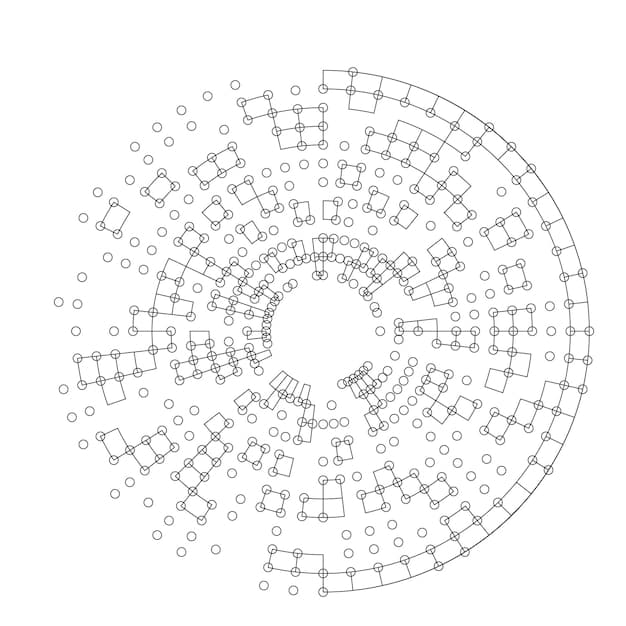Quantum Computing & Data Encryption: A US Security Revolution

Quantum computing’s potential to break current encryption standards poses significant challenges and opportunities for data security in the United States, necessitating proactive mitigation strategies.
The emergence of quantum computing presents both a monumental leap in computational power and a considerable threat to existing data encryption methods. This article delves into the impact of quantum computing on data encryption: A US perspective, examining the vulnerabilities, challenges, and potential solutions within the United States.
Understanding Quantum Computing and its Potential
Quantum computing leverages the principles of quantum mechanics to perform calculations far beyond the capabilities of classical computers. This exponential increase in processing power has the potential to revolutionize fields like medicine, materials science, and artificial intelligence, but also poses a significant threat to cybersecurity.
How Quantum Computers Work
Unlike classical computers that use bits representing 0 or 1, quantum computers use qubits. Qubits can exist in a superposition of both 0 and 1 simultaneously, and they can also be entangled. This allows quantum computers to perform calculations that are impossible for even the most powerful classical computers.
The Promise of Quantum Computing
The potential benefits of quantum computing are vast. It can accelerate drug discovery, optimize complex logistical systems, and even break current encryption algorithms. However, this very capability is what raises serious concerns about data security.

- Enhanced simulations for scientific research.
- Revolutionary advancements in artificial intelligence and machine learning.
- Optimization of complex financial models and logistical operations.
- Breakthroughs in materials science leading to new materials with enhanced properties.
The development and deployment of quantum computers present a dual-edged sword. While the potential benefits are transformative, the security risks are equally significant. Understanding these risks and preparing for them is crucial, especially for the United States, which is a leader in both technology and national security.
The Vulnerability of Current Encryption Methods
Most of the encryption methods currently used to protect sensitive data, such as RSA and ECC, rely on mathematical problems that are difficult for classical computers to solve. However, quantum computers, using algorithms like Shor’s algorithm, can efficiently solve these problems, rendering these encryption methods obsolete.
Shor’s Algorithm and its Implications
Shor’s algorithm is a quantum algorithm that can factor large numbers exponentially faster than the best-known classical algorithms. This means that a quantum computer running Shor’s algorithm could break RSA encryption, which is used to secure a wide range of online transactions and communications.
Impact on Data Security
The vulnerability of current encryption methods to quantum computers has significant implications for data security. It threatens the confidentiality, integrity, and availability of sensitive data, including financial records, medical information, and government secrets.
The United States, with its vast digital infrastructure and reliance on secure data transmission, is particularly vulnerable to quantum attacks. Protecting this data requires a proactive and comprehensive approach.

- E-commerce and online banking become vulnerable to fraud.
- Sensitive government communications could be intercepted and decrypted.
- Critical infrastructure systems could be compromised, leading to disruptions and potential disasters.
- Intellectual property and trade secrets could be stolen by malicious actors.
In conclusion, the potential of quantum computers to break current encryption methods represents a significant threat to data security in the United States. Understanding the nature of this threat and developing effective countermeasures is essential for maintaining national security and economic stability.
Post-Quantum Cryptography (PQC): A Potential Solution
Post-quantum cryptography (PQC) refers to cryptographic algorithms that are believed to be secure against both classical and quantum computers. These algorithms are designed to replace existing encryption methods that are vulnerable to quantum attacks.
NIST’s PQC Standardization Process
The National Institute of Standards and Technology (NIST) is currently conducting a standardization process to identify and validate PQC algorithms. This process involves evaluating various candidate algorithms based on their security, performance, and practicality.
Types of PQC Algorithms
Several types of PQC algorithms are being considered, including lattice-based cryptography, code-based cryptography, multivariate cryptography, and hash-based cryptography. Each of these approaches relies on different mathematical problems that are believed to be resistant to quantum attacks.
The US government and private sector are actively involved in researching and developing PQC algorithms. This collaborative effort is essential for ensuring that the United States remains at the forefront of cybersecurity innovation.
- Lattice-based cryptography offers a balance of security and performance.
- Code-based cryptography provides strong security guarantees based on error-correcting codes.
- Multivariate cryptography presents challenges related to key size and performance.
- Hash-based cryptography relies on the collision resistance of hash functions.
Adopting post-quantum cryptography is a crucial step in mitigating the risks posed by quantum computers. NIST’s standardization process is paving the way for the development and deployment of secure and practical PQC algorithms, ensuring long-term data protection in the United States.
Challenges in Implementing PQC
While PQC offers a promising solution to the quantum threat, implementing it faces significant challenges. These challenges include performance overhead, key size limitations, and the complexity of transitioning to new cryptographic systems. There are steps to transition to PQC in the transition from classical to Quantum computing.
Performance and Scalability
PQC algorithms often have higher computational overhead than current encryption methods, which can impact performance, especially in resource-constrained environments. Ensuring that PQC algorithms can scale to meet the demands of modern applications is essential.
Key Management and Distribution
Managing and distributing cryptographic keys is always a challenging task, and it becomes even more complex with PQC. Developing secure and efficient key management systems is critical for the successful deployment of PQC.
The transition to PQC requires careful planning and execution. Organizations need to assess their current cryptographic infrastructure, identify vulnerable systems, and develop a migration strategy. Education and training are also essential to ensure that IT professionals have the skills and knowledge needed to implement and maintain PQC systems.
- Balancing security with performance requirements.
- Managing the complexity of key generation and distribution.
- Ensuring interoperability between different PQC algorithms and systems.
- Addressing the potential for side-channel attacks on PQC implementations.
Overcoming these challenges requires a collaborative effort between industry, government, and academia. Investing in research and development, establishing best practices, and promoting education and awareness are all critical steps in successfully implementing PQC in the United States.
The Role of the US Government
The US government plays a vital role in preparing for the quantum threat. Government agencies are responsible for developing standards, providing funding for research and development, and coordinating the national response to quantum-related cybersecurity threats.
NIST and its Standardization Efforts
As mentioned earlier, NIST is leading the effort to standardize PQC algorithms. This standardization process provides a clear roadmap for organizations looking to adopt PQC and ensures that the algorithms used are secure and interoperable.
Funding and Research Initiatives
The US government is investing heavily in quantum computing and PQC research. These investments support the development of new algorithms, the testing of existing algorithms, and the training of a workforce capable of designing, implementing, and maintaining PQC systems.
Collaboration between government, industry, and academia is essential for addressing the quantum threat effectively. By sharing information, coordinating research efforts, and developing common standards, the United States can maintain its leadership in cybersecurity.
- Providing clear guidance and standards for PQC adoption.
- Supporting research and development of quantum-resistant technologies.
- Promoting education and awareness of the quantum threat.
- Collaborating with international partners to develop global cybersecurity standards.
In conclusion, the US government’s role in preparing for the quantum threat is multifaceted and crucial. By leading standardization efforts, funding research initiatives, and fostering collaboration, the government is helping to ensure that the United States remains secure in the quantum age.
Preparing for the Quantum Era: A Call to Action
The emergence of quantum computing presents a complex and evolving challenge to data security. Preparing for the quantum era requires a proactive and coordinated effort from organizations, government agencies, and individuals.
Assessing Vulnerabilities and Risks
Organizations need to assess their current cryptographic infrastructure and identify systems that are vulnerable to quantum attacks. This includes identifying sensitive data, evaluating the lifespan of that data, and prioritizing systems for PQC implementation.
Implementing PQC in Critical Infrastructure
Critical infrastructure systems, such as power grids, water treatment plants, and transportation networks, are particularly vulnerable to quantum attacks. Implementing PQC in these systems is essential for protecting national security and public safety.
The transition to a quantum-safe world requires a long-term commitment and ongoing investment. By focusing on vulnerability assessment, PQC implementation, and collaboration, the United States can mitigate the risks posed by quantum computers and ensure the security of its data in the years to come.
- Start planning for PQC adoption now.
- Stay informed about the latest developments in PQC research and standardization.
- Collaborate with industry partners and government agencies to share knowledge and best practices.
- Invest in education and training to develop a workforce capable of implementing and maintaining PQC systems.
In summary, preparing for the quantum era requires a comprehensive and coordinated approach. By taking proactive steps to assess vulnerabilities, implement PQC, and foster collaboration, the United States can protect its data and maintain its leadership in cybersecurity.
| Key Point | Brief Description |
|---|---|
| 🛡️ Quantum Threat | Quantum computers can break current encryption. |
| 🔑 Post-Quantum Cryptography | New algorithms resistant to quantum attacks. |
| 🏛️ US Government’s Role | NIST standardization and funding for research. |
| 🚀 Preparing for the Future | Assessing vulnerabilities and implementing PQC. |
FAQ
▼
Quantum computing uses quantum mechanics principles to perform complex calculations much faster than classical computers. This enables solutions to problems that are currently impossible.
▼
Quantum computers can run Shor’s algorithm, which efficiently breaks many of the current encryption methods like RSA and ECC, compromising data security across various systems.
▼
PQC refers to cryptographic algorithms designed to be secure against both classical and quantum computers, offering a potential solution to quantum-based threats to data encryption.
▼
NIST is standardizing PQC algorithms to ensure they are secure, effective, and interoperable, providing a clear path for organizations to adopt quantum-resistant cryptography.
▼
Organizations should assess vulnerabilities, start planning for PQC adoption, stay informed about advancements, and collaborate with industry and government bodies for best practices and support.
Conclusion
The impact of quantum computing on data encryption represents a paradigm shift in cybersecurity. As the United States navigates this evolving landscape, proactive measures, including the adoption of post-quantum cryptography and increased collaboration, are essential to safeguarding sensitive data and maintaining national security in the quantum era.





